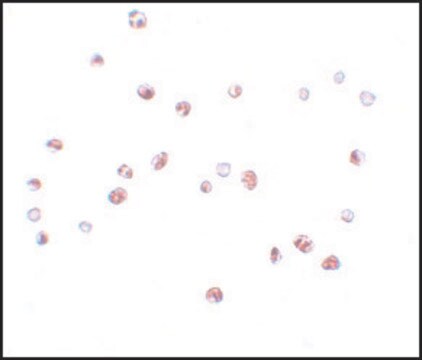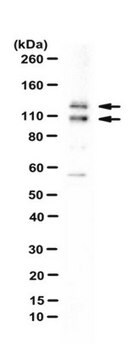MABF260
Anti-NLRC5 Antibody, clone 3H8
clone 3H8, from rat, purified by using protein G
Synonym(e):
Protein NLRC5, Caterpiller protein 16.1, CLR16.1, Nucleotide-binding oligomerization domain protein 27, Nucleotide-binding oligomerization domain protein 4
About This Item
Empfohlene Produkte
Biologische Quelle
rat
Qualitätsniveau
Antikörperform
purified antibody
Antikörper-Produkttyp
primary antibodies
Klon
3H8, monoclonal
Aufgereinigt durch
using protein G
Speziesreaktivität
human
Methode(n)
flow cytometry: suitable
immunoprecipitation (IP): suitable
western blot: suitable
Isotyp
IgG1, kappa
UniProt-Hinterlegungsnummer
Versandbedingung
wet ice
Posttranslationale Modifikation Target
unmodified
Angaben zum Gen
human ... NLRC5(84166)
Allgemeine Beschreibung
Spezifität
Immunogen
Anwendung
Entzündung & Immunologie
Immunoglobuline & Immunologie
Immunoprecipitation Analysis: A representative lot detected poly(I:C) (Cat. No. 528906) treatment-induced upregulation of endogenous NLRC5 in HeLa cells by IP-Western blotting analysis of both cytosolic and nuclear fractions. A strong NLRC5 nuclear accumulation was seen upon nuclear export inhibition by LepB (Cat. No. 431050) treatment, whereas NLRC5 was mainly cytoplasmic in untreated cells (Neerincx, A., et al. (2012). J. Immunol. 188(10):4940-4950).
Western Blotting Analysis: A representative lot detected NLRC5 in THP-1 cell lysate as well as exogenously expressed FLAG-tagged NLRC5 in lysate from transfected HEK293T cells. Target band detection was greatly diminished using lysates from NLRC5 siRNA-transfected THP-1 cells. (Neerincx, A., et al. (2010). J. Biol. Chem. 285(34):26223-26232).
Qualität
Western Blotting Analysis: 1 µg/mL of this antibody detected NLRC5 in 10 µg of Raji cell lysate.
Zielbeschreibung
Physikalische Form
Lagerung und Haltbarkeit
Sonstige Hinweise
Haftungsausschluss
Sie haben nicht das passende Produkt gefunden?
Probieren Sie unser Produkt-Auswahlhilfe. aus.
Lagerklassenschlüssel
12 - Non Combustible Liquids
WGK
WGK 1
Flammpunkt (°F)
Not applicable
Flammpunkt (°C)
Not applicable
Analysenzertifikate (COA)
Suchen Sie nach Analysenzertifikate (COA), indem Sie die Lot-/Chargennummer des Produkts eingeben. Lot- und Chargennummern sind auf dem Produktetikett hinter den Wörtern ‘Lot’ oder ‘Batch’ (Lot oder Charge) zu finden.
Besitzen Sie dieses Produkt bereits?
In der Dokumentenbibliothek finden Sie die Dokumentation zu den Produkten, die Sie kürzlich erworben haben.
Unser Team von Wissenschaftlern verfügt über Erfahrung in allen Forschungsbereichen einschließlich Life Science, Materialwissenschaften, chemischer Synthese, Chromatographie, Analytik und vielen mehr..
Setzen Sie sich mit dem technischen Dienst in Verbindung.








